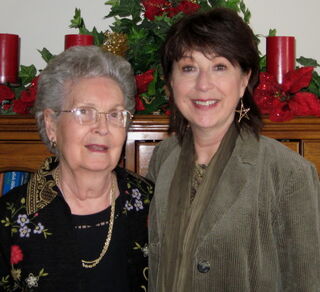
Grief
Elder Grief 3: How to Move Your Loved One into Assisted Living
Five Suggestions from a Daughter Who's Been There
Posted September 8, 2012
It’s been a little over a month since I moved my 93-year-old mother from independent to assisted living. This was her second move in three months. Fortunately, both were within the same building, which prompts my first suggestion.

Suggestion 1: When choosing an assisted living community, try to find one with progressive care.
My mother and stepfather had moved into such a facility six years ago—on the independent living side. Their rent included one meal a day in the dining room, planned activities, and lots of autonomy for how they conducted their lives in a community of their peers.
The ensuing years saw my stepfather’s health decline, necessitating both rehab in the adjacent nursing home and then two different assisted living situations—one of which allowed him and my mother to still have meals together and visit back and forth. The other put them in different buildings, greatly decreasing their time together.
Suggestion 2: Especially when dealing with an elderly couple, look for situations that will facilitate rather than hinder their continued relationship.
Even when their care needs differ, the companionship is emotional support whose importance cannot be overstated. And, sadly, you never know when things are going to take a sudden turn for the worse, as they did for my mother this year.
After much discussion about the potential strain that a move might cause to her health, we downsized her living situation from the two-bedroom apartment she had shared with my stepfather to a lovely one-bedroom on the same floor. That was May 18.
On May 22, our worst fears were realized when she fell in her closet, fracturing her mid-back and launching us on the wild healthcare ride that eventuated in my downsizing her accommodations one more time—now to a studio apartment in assisted living. Fortunately, she is son the same floor in the building where my stepfather has relocated, so they are once again having meals together and visiting as much as their health allows.
Suggestion 3: Talk about declining health and increased care options and preferences long before the decision is imminent.
Several years ago my mother and I had a long discussion about what she would want, should her health decline. We talked about how well-meaning adult children often bring their elderly parents to live with them—much as was the custom in previous generations. Sometimes it works and sometimes it doesn't.
We admitted that, at least in our situation, that would not be an optimal solution. I am a widow who never had children. I am also an only child. So the full weight of my mother’s care would be on my shoulders. I had already been a full-time caregiver for my husband in his final months with terminal cancer. That was possible only because he remained able to care for himself until two weeks before he died. Except for the fact that he was dying of cancer, he was very healthy, mentally acute, and amazingly strong in his ability to handle the various pains of his illness.
My mother is nearly forty years older than my husband was at the end of his life. She has multiple chronic conditions and is in persistent pain that is manageable only with a complex regime of narcotics and physical therapy.
In the last year, she has lost 10 pounds and 1.5 inches in height. She uses a walker now. And while she still gets around better than many her age, her interest in activities has waned significantly. In fact, her daily life consists mostly of marshaling her strength to walk to and from meals and taking minimal care of her personal needs.
It is impossible to predict what your loved one’s situation will be as they age—except to know that chances are good that, barring a dramatic event, they will continue to live with increasing frailty and progressively declining abilities that will require more help than one family member can provide.
My mother and I also frankly discussed that she might feel like a prisoner in my home. Not because I am cruel or unfeeling, but because she would not be living with her own community of friends. She continues to be a person who needs the company of others and her assisted living situation provides that.
She goes to the dining room for lunch and dinner. Her hairdresser is just down the hall in the small salon provided for residents. She can make an appointment to have her nails done if she wishes. On Sunday mornings there is an on-site chapel service. The lobby, gift shop, and coffee bar areas facilitate informal conversation. And the staff work very hard to provide entertainment and activities that foster community in multiple ways.
If my mother lived with me, she would have none of those options. I’m still working and our tastes, while similar in some ways, are very, very different in others. I love my mother, but I don’t want to live with her—and she doesn’t want to live with me. We both know that—which has made the decision to work through the challenges of assisted living easier than it might have been, had we not talked through the various scenarios.
Nevertheless, when it came time to bring my mother “home” from rehab in the nursing home across campus, creating a new environment in which she would be content (it’s hard to be happy in assisted living) was a challenge.
It was physically difficult for me because, strangely, on the weekend when the move had to be done, I didn’t have much help. Since then I’ve told people, “Never underestimate the power of a small woman and two hand trucks.” But the point is not that I was able to move her furniture down the hall. (Thank God all of these moves took place on the third floor!). The point is the fourth suggestion:
Suggestion 4: Familiarity—know what possessions are important to your loved one(s) and create an environment that feels like home—even if their new home is now smaller than their first tiny apartment from seventy years ago.
Again, I was fortunate because my mother and I have always been great pals. Although we lived across the country from each other for thirty years, we have been in the same city for the last decade. Our decorating tastes are very different, but I know what she likes. Beauty is vital to her sense of well-being and I know what creates beauty for her.
She remains practical and organized, so I made sure that there was still room for her desk and lots of drawers, a table where she can have breakfast in her little kitchenette, and a corner for her curio cabinet. I hung her favorite artwork and made sure that all of her clothes fit into closets where she could reach them.
Fortunately, she and I had already eliminated many extraneous possessions for the first move in May so I didn’t have to do a lot of sorting. And, as great good fortune would have it, her new assisted living apartment was one that my stepfather had occupied before a long stint at the nursing home. So my mother knew the floor plan, which allowed me to discuss with her my plans for arranging her belongings. When I brought her home, it was as if she already lived there.
Suggestion 5: Involve your loved ones in decisions about their future and honor their choices.
Obviously, this becomes very difficult if their cognitive abilities are compromised. And creating an environment that feels like home is a challenge if you’re not sure what they like. But, as much as possible, ask what they want. Give them some choices and recognize that what seems trivial to you may be essential to them.
Respect for one’s personal environment and a sense of autonomy—however diminished—is something each of us appreciates. As our loved ones decline—often becoming living ghosts of who they used to be—it is vital that we, as their caregivers and advocates, retain the awareness that there is still a heart and soul in that frail body. The essence of the person remains and cries out for recognition.
The very old and sick among us are often at a loss to understand why they are still here. Having lived their lives and now experiencing so little quality of life can turn existence into a challenge unlike any they have ever faced.
So the more that we and those who provide their care in assisted living facilities can do to provide an environment of love and compassionate support, the more likely it is that our darling ones may still find meaning and joy in the days they have left.
To recap, here are the five suggestions:
- When choosing an assisted living community, try to find one with progressive care.
- Especially when dealing with an elderly couple, look for situations that will facilitate rather than hinder their continued relationship.
- Talk about declining health and increased care options and preferences long before the decision is imminent.
- Familiarity—know what possessions are important to your loved one(s) and create an environment that feels like home.
- Involve your loved ones in decisions about their future and honor their choices.
Copyright (c) 2012 Cheryl Eckl



